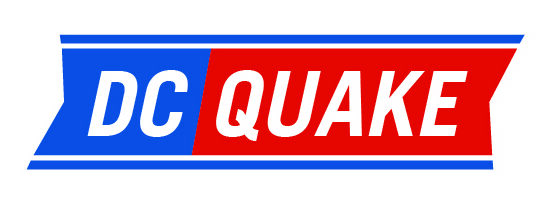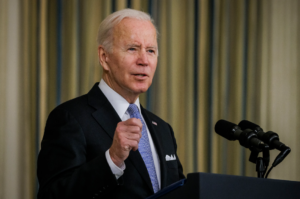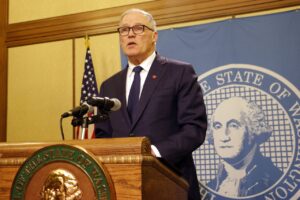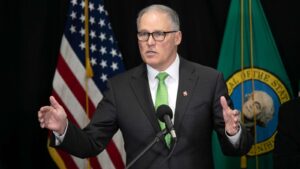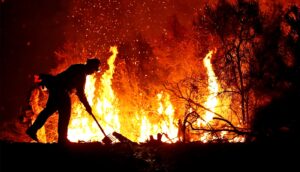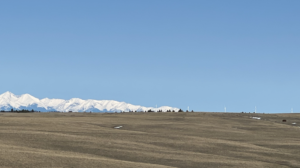Biden calls for mandating vaccines for teachers, more testing in schools — but his authority is limited
6 min read
As the delta variant continues to complicate the start of the new school year, President Biden called on states to require school staff get vaccinated and for public schools to regularly test students and staff for COVID.
“We know that if schools follow the science, and implement the safety measures like testing, masking, adequate ventilation systems, social distancing, and vaccinations, then children can be safe from COVID-19 in schools,” Biden said in a speech Thursday in which he outlined several steps to quell the virus.
The administration also said staff who work in Head Start programs and in schools run by the Bureau of Indian Affairs and Department of Defense will be required to be vaccinated. That represents a small fraction of the nation’s school staff— some 300,000 people — but shows the federal government is willing to use the limited power it does have to ensure some school staff are vaccinated.
Biden continues to position schools as a crucial part of his agenda to bolster the economy and limit the spread of the virus. He said “keeping our children safe and our schools open” was perhaps the most important part of his plan. But that plan also illustrates the limited tools the federal government has to dictate what local schools do.
Presently, school district COVID testing policies vary widely. In a survey of policies among 100 large urban school districts, nearly half do not regularly test staff or students. Others, though, had frequent testing of both.
Vaccination policies also vary widely with a small but growing number of states and districts requiring shots for staff. In many other cases, districts do not require vaccines for staff and in some states, schools are barred from doing so.
Meanwhile, the delta variant has already upended the start of the school year for many schools and students. COVID rates among children — who aren’t eligible for the vaccine until they turn 12 — have spiked in recent weeks, although hospitalization is still relatively rare. In some parts of the country, large swaths of students have missed school because they contracted COVID-19 or were exposed to it. Schools have struggled to provide them with continuous instruction.
In its plan, the White House said that with frequent testing “schools will better be able to remain open for in-person learning and maintain the health and safety of all students, staff, and families.”
COVID testing in schools can help catch infections early and lower the risk of in-school transmission by keeping infecting individuals out of schools, the Centers for Disease Control and Prevention says. Testing can also help families feel more secure about sending their children to school in person.
But how often to test and whether tests should be required has been a point of contention in some districts. In Chicago, for example, students will be offered voluntary COVID tests weekly, though the teachers union wanted testing to be mandatory. But there have been delays in setting up the testing program.
In New York City, schools plan to test 10% of unvaccinated students every other week. But families have to give their consent, and some parents don’t support testing students because they fear it will result in the detection of more positive cases and school closures.
Back in March, federal officials set aside $10 billion to help school districts set up and pay for COVID testing programs. But even with funding, testing programs can be logistically challenging to start. Districts that want to test on site instead of in a lab have to obtain special certification, work closely with public health officials, and comply with privacy laws. School officials may have to train staff to administer tests and get buy-in from families and staff.
“Some people felt like [testing] was ‘Big Brother’ at first,” a school official in Aurora, Colorado told researchers who examined various testing policies. “But once people saw it was easy, they were getting results back quickly, that eased their concerns.”
Even the CDC has said that “the benefits of school-based testing need to be weighed against the costs, inconvenience, and feasibility of such programs to both schools and families.” One downside: false positives can lead to unnecessary exclusion from school.
“The reality is that testing is not what it could be,” said Noelle Ellerson Ng, advocacy director at AASA, the school superintendents association. “There are multiple reasons why testing is not more widely used, from supply, access and cost to logistics, consent and staffing.”
One illustration of that is in Colorado. The state has set aside $173 million for free weekly testing of students and staff in K-12 schools and even offered financial incentives to students who participate. But so far, less than a quarter of public and private schools have signed onto the free program.
Denver Public Schools leaders have noted that testing presents logistical issues ranging from staffing to getting parental consent. District leaders said they’ve been advised by public health authorities to use the city’s free testing sites that exist outside of schools instead. “Doctors continue to recommend that is the best testing strategy we can put in place,” said Jessica Ridgway, a Denver schools official.
Some districts may be open to adding testing to help keep more kids in school. In recent weeks, some districts have begun administering rapid COVID tests as an alternative to quarantining students who’ve been exposed to the virus. And some states have had success in boosting testing. In Illinois, some 45% of schools are participating in the state’s free COVID testing program.
Meanwhile, Biden also called for more districts to require staff to get vaccinated. Public health experts say that widespread vaccination is the best way to reduce the spread of the virus. The vaccines substantially reduce an individual’s chances of contracting, spreading, and becoming seriously ill from COVID-19.
The federal government issued its own vaccine requirements for schools that it controls. But outside of these schools it’s not clear to what extent Biden’s encouragement will make a difference. On Thursday afternoon the White House provided little information on how it would turn this aspiration into reality, framing the announcement as a friendly request. “The President is asking more states to join in requiring the vaccine for school employees to make sure we are keeping students safe,” a White House document says.
Throughout the pandemic the federal government has struggled to exert authority over state and local school officials, starting with the Trump administration’s effort to get schools to open their buildings last fall.
On the vaccine front, the country’s teachers unions — whose national affiliates are allies of the Biden administration — have held a patchwork of views on vaccine mandates for their members. American Federation of Teachers President Randi Weingarten publicly embraced the idea, while National Education Association president Becky Pringle has backed requiring either a vaccine or weekly testing. But some local unions have resisted vaccine requirements or fought with school officials over details.
For example, New York City and its teachers union, AFT’s largest local, are still finalizing a vaccine mandate policy, and have clashed over what should happen to staff who refuse to get the vaccine.
It’s not clear precisely what share of the nation’s public school staff remains unvaccinated, although it’s likely a sizable minority.
The Biden administration did not mention vaccine mandates for schoolchildren. (Los Angeles appears poised to become the first major district to require eligible students to get vaccinated to attend school in person.) But the administration did say it will work to provide resources to the Food and Drug Administration to support the swift review and approval of a vaccine for children under 12. And in his speech Biden encouraged vaccines for those eligible. “Parents, please get your teenager vaccinated,” he said.
Meanwhile, the Biden administration is in the midst of a pressure campaign against states that ban mask mandates, although it’s unclear how successful this will be. On Thursday the administration doubled down. The Department of Education announced a new grant program to backfill any money that school districts lose from their states because they issue mask mandates. The White House also said the department should continue to use its “full legal authority” to press states to allow for mask requirements.
“If these governors won’t help us beat the pandemic,” Biden said of state leaders who’ve tried to ban school mask mandates, “I’ll use my power as president to get them out of the way.”
This article was originally posted on Biden calls for mandating vaccines for teachers, more testing in schools — but his authority is limited
